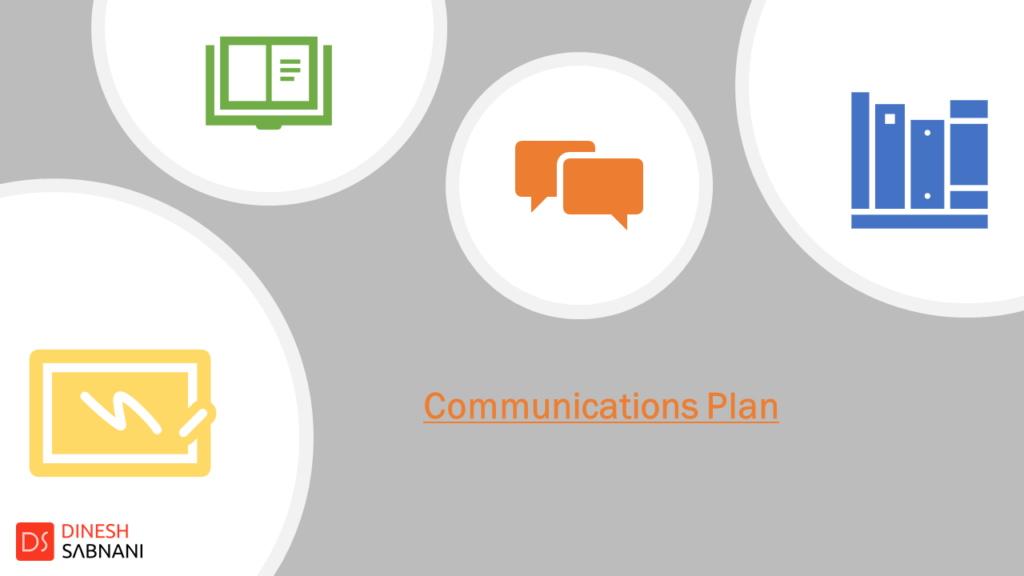I can understand last 3 blogs were brainteasing. You must have put a lot of focus to go over those blogs and at the same time project planning on 3 important project parameters – scope, time and cost needs attention to detail to make it perfect. 1 missed or extra assumption can make the entire project planning for a toss and you need to do it all over again. The perfection with planning comes with practice and believe me, all these concepts are mostly common sense but has a great potential to bring the project delivery to the next level if everything is done with perfection.
Similar to planning for scope, time and cost, today we are going to talk about communication planning.
In this blog, we are going to talk about importance of communication and communication planning. Yes, Project manager carry this important responsibility of setting the communication plan for the project and for the project team members. Communication plan is nothing but setting rhythm of communication, connecting to right point of contact in dealing with any situation and create opportunity for the project team members to exchange information with each other in appropriate way.
Let’s see ahead what are the important aspects of communication planning
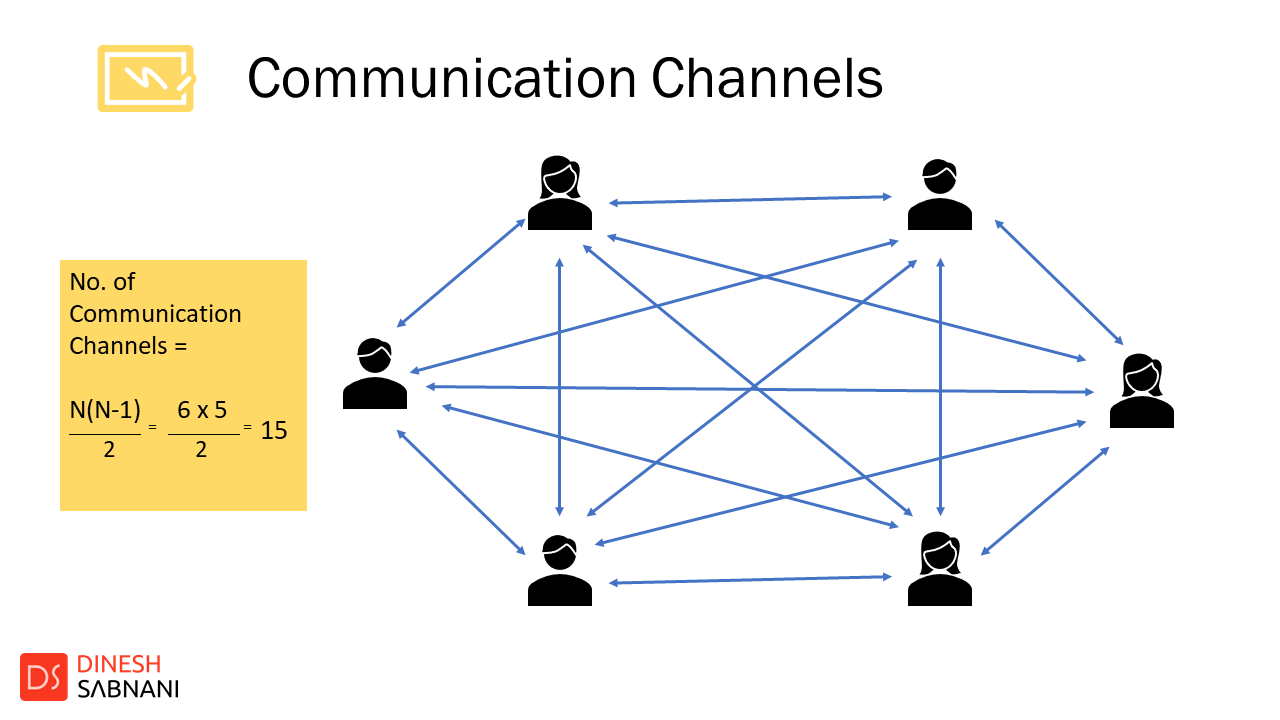
Let’s see what is communication channel.
Communication channel is path of communication between 2 members in the project.
It can be of 3 types:
1. It can be a 1 on 1 discussion between 2 members
2. It can be a seminar or a presentation where 1 person is connecting with multiple members
3. It can be a group discussion or a social gathering where multiple people are interacting with each other.
Communication can take place multiple forms. So to calculate the maximum stretch to manage and control, there is a formula to calculate the no. of channels in a given project. The Formula is N multiply by (N-1) divide by 2.
Let’s take an example, If you have 6 members in the project. the total number of channels will be 6*5/2 = 15. There can be 15 communication channels which can take place in the project. Isn’t this huge?
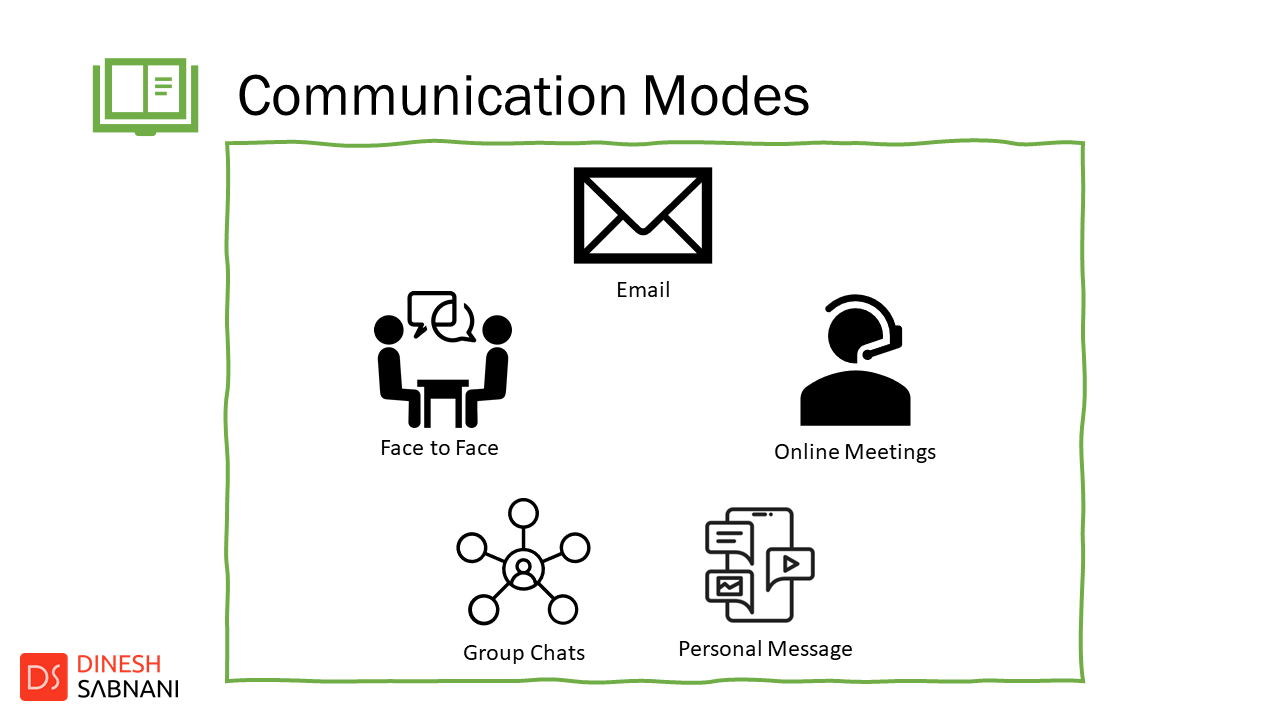
Let’s see what are different kinds of Communication Modes used in in today’s world, Project team members have been located remote in today’s scenario and influence of communication using technology is innate which cannot be taken out of the system.
Different modes of communication opted by current project teams are:
1. face to face communication – It a way of having direct verbal conversation with another project team member.
2. Email – Email is considered to be the most professional way of communication since many years. It’s a way of formal communication mode for sharing project updates, reports or any other kind of important information you need to share.
3. Online Meetings – Meetings conducted online are formal gatherings within project team, conducted by meeting coordinator and it has a set agenda to cover within a limited span of time.
4. Personal Messages – It’s an another way of direct communication, this includes not just chat but sharing of documents, artefacts, Internet links and Media content.
5. Group Chats – Group chats are considered to be the most effective, fast and light weight conversation mode. Sharing information or artefacts via group chat have seen better acceptance, usage and response time compared to other communication modes.
So having so many Communication Channels and Modes, the important aspect for Project manager is to narrow down into few of them which the team will use for project communications. Using all of them or having multiple modes can create a chaos and we definitely don’t want that to happen.
Project manager helps in selecting the right tools based on the project scenario and set the appropriate guidelines for using them.
Now let’s see what includes in the Communication Plan
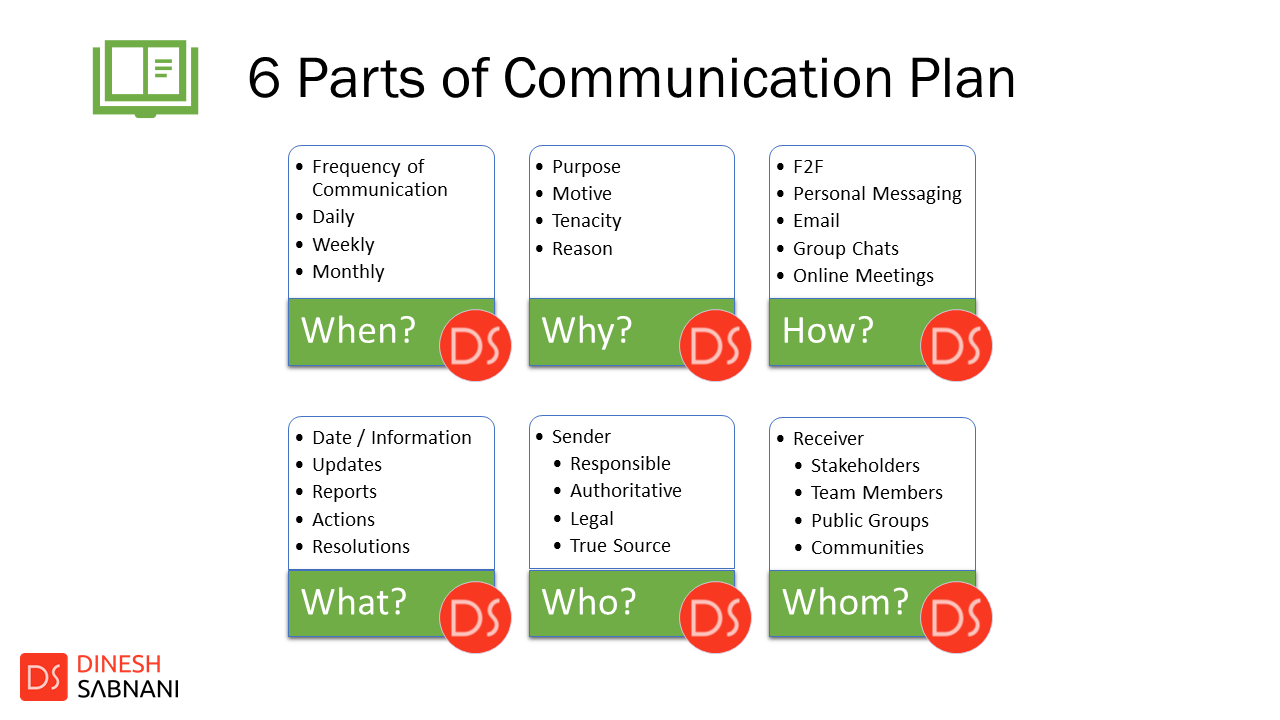
The Communication plan comprises of what really is needed to be accomplished as part of setting up the right communication model for the project. Let’s cover this with the help of these questions
1. When? – When do we think the certain set of communication should be triggered, whether it should be on specific date and time, or having a recurrence on certain time intervals.
Example is Adhoc Catchups, Daily standups, Weekly status reports or Monthly project review
2. Why? – This clarifies what purpose is getting solved by doing the communication at required intervals. Example, is awareness, gaining interest of right stakeholder, intrinsic actions required to be taken, raising an alarm on difficult situation or request for Help & support.
3. How? – This covers communication modes which we discussed. The mode is chosen based on the response time you expect and also, based upon the importance of message. Choosing the right mode for a message to be transferred is utmost important to gain required attention.
4. What? – This covers what message is sent as part of the communication. Example it can be, action items for team members, project updates, a generic message or a important note. The message in the communication makes the sender and the receiver accountable of that information.
And the last 2 questions are Who? And Whom? – This covers who is responsible to send the information and who is responsible to receive and consume the information. The source and target audience of the message are very important to be understood before communication is sent. From my experience, this is most important when you intend to broadcast the information to the group, while making sure all important stakeholders are part of that group.
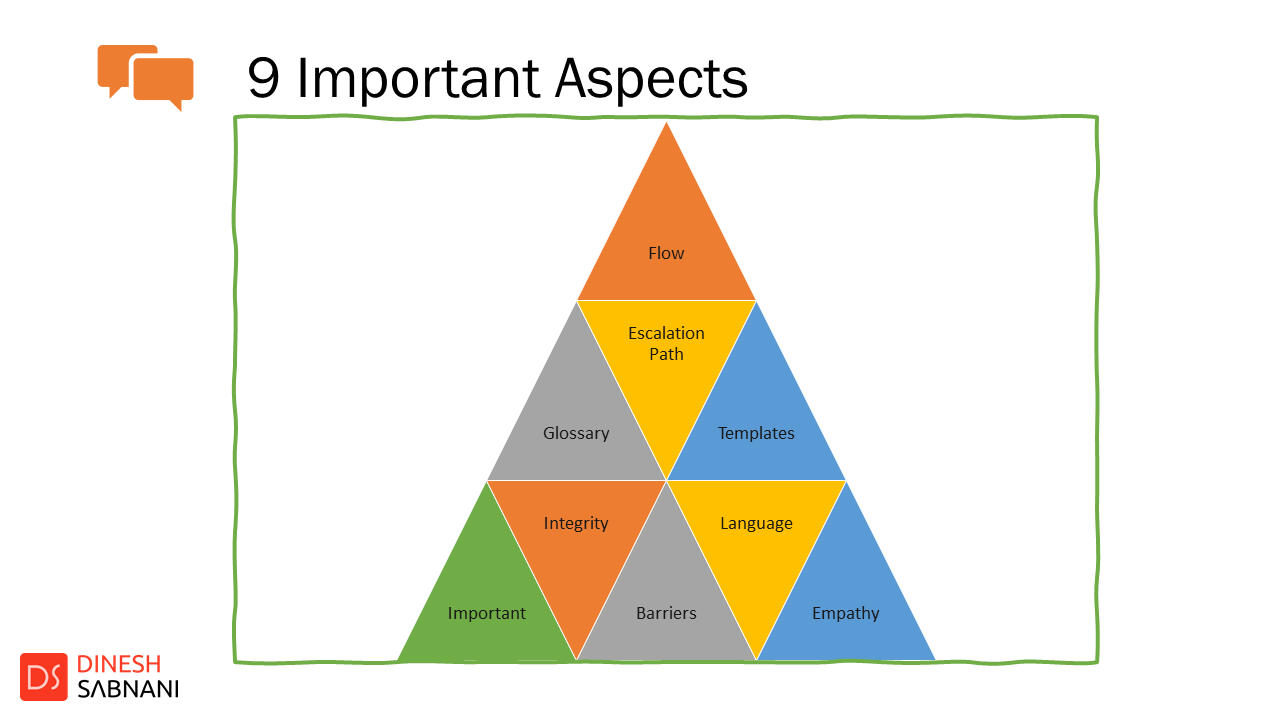
After covering 6 basic question for creating a communication plan. There are still some important aspects of communication which needs to be taken care of.
Flow: The information is transmitted through communication channels. This Information flow is important between the people who are working on same module and also sharing the progress with entire team.
Escalation Path: The escalation path is needed to pull the right authority to resolve any problem. The case / query follow through an escalation path to bring the attention and also control the information flow to avoid sending message to non-required audience for a given situation.
Glossary: It is about the terminology used by project team members in the given context of the project being undertaken. The short names or acronyms should be made aware by entire project team.
Templates: Templates helps to avoid re-inventing the wheel in deciding how to write / describe the particular information. Example, Status report template, we just need to the use the template to fill the information and send it. Alterations are avoided to be made in template as much as possible
Important: While sending an important message, it is required that message should be marked as Important, so that required attention is received. Sometimes, we also mark the message as Urgent, to receive immediate response.
Integrity: Sender of the message needs to hold the ownership of sending the particular information. Integrity lies in the message defines it to be correct, came from a true source and informative, which can be consumed with trust to react, respond and do certain actions.
Barriers: Communication Barriers are to be considered while transiting the information. Examples are Language barriers, technology challenges, role based access controls, etc. Taking them into consideration is of utmost importance in order to achieve the successful reception of the message by the right audience.
Language: Language of communication is of most important, sometimes we work in diverse groups from various parts of the world. So that having a common language would make more sense. English is the most common language used in a corporate setting, but it is required to have translation service used to help and serve the countries which are from non-English speaking regions.
And lastly is Empathy: This plays the most significant role. Having empathy in communication makes the understanding of need and importance of the messages implies to both the sender and receiver. Information are exchange to achieve the greater good, maintaining relationships, have respect for individual and on top of all to achieve the goal of the project.
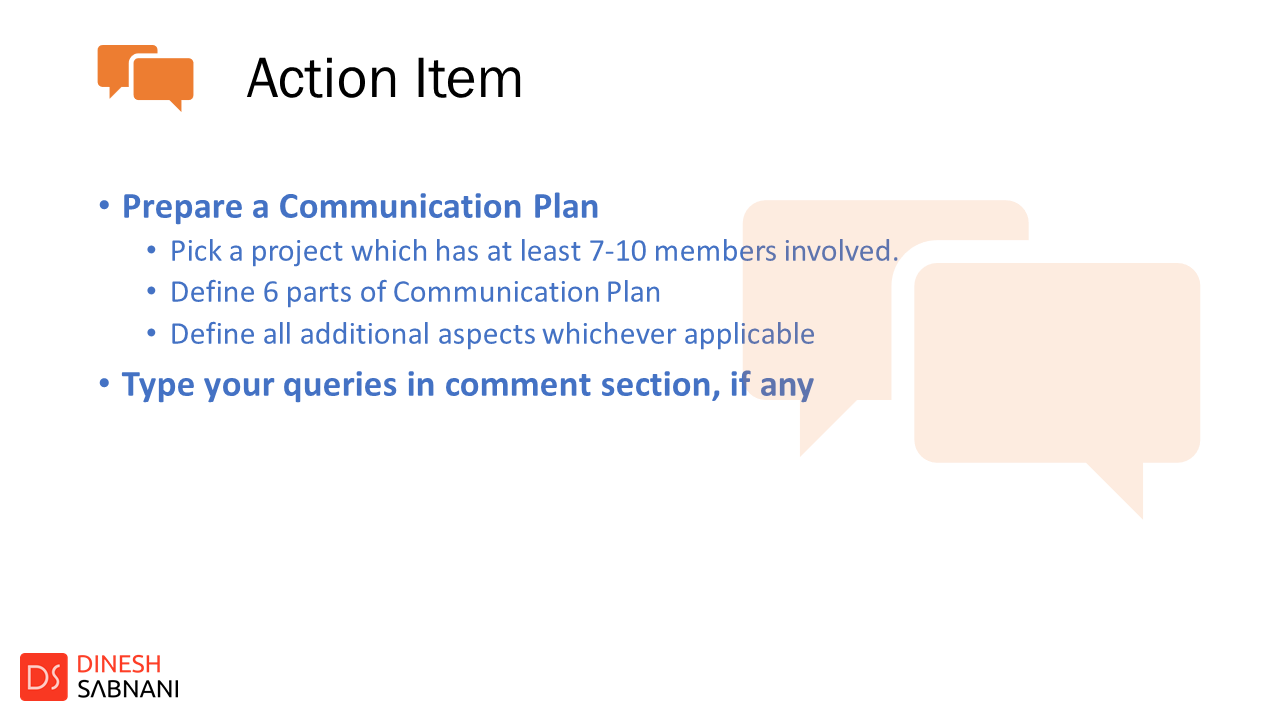
It’s time for action item.
Prepare the communication plan for the project covering the 6 parts of communication plan and narrow down communication modes that you will use for the project.
Also, Try to reflect upon the 9 Important aspects covered in this episode. This will make it realize why communication planning is so important to achieve success in project.
So friends, this was all about the communication planning. I believe this blog must have been eye opener for you in many aspects. A very simple thing of communication can carry so much weightage in project planning, you can imagine how a wrong information flow can impact so much in project execution.
Thank you all, That’s all for this Blog, Have a Great day, Bye Bye.


